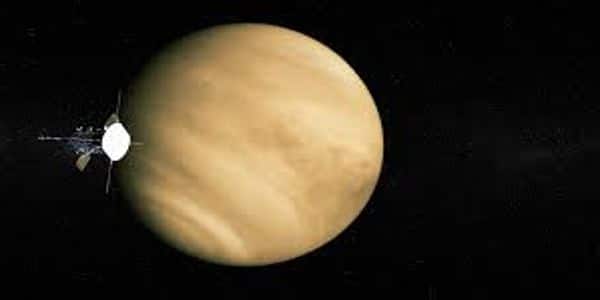Stunning views of Venus were captured by NASA’s Parker Solar Probe during a close flyby of the planet in July 2020. For more information, the WISPR team intends to conduct a series of similar observations of Venus’s nightside during Parker Solar Probe’s next Venus flyby on Feb. 20, 2021. Scientists on the mission team anticipate receiving and processing the data for analysis by the end of April. Stunning views of Venus were captured by NASA’s Parker Solar Probe during a close flyby of the planet in July 2020.
Though the Parker Solar Probe’s primary focus is the Sun, Venus plays an important role in the mission: the spacecraft passes by Venus seven times during its seven-year mission, using the planet’s gravity to bend the spacecraft’s orbit. These gravity assists from Venus allow the Parker Solar Probe to fly closer and closer to the Sun as part of its mission to study the dynamics of solar wind near its source.
However, in addition to orbital dynamics, these passes can provide some unique and even unexpected views of the inner solar system. On July 11, 2020, during the mission’s third Venus gravity assist, the Wide-field Imager for Parker Solar Probe, or WISPR, captured a stunning image of the planet’s nightside from 7,693 miles away.
NASA’s Parker Solar Probe captured stunning views of Venus during its close flyby of the planet. Mission team scientists expect to receive and process that data for analysis by the end of April.
Parker Solar Probe was launched in August 2018 with the audacious mission of flying closer to the sun than any previous spacecraft. However, the probe must fly past Venus seven times, with each pass bringing the spacecraft closer to the sun. While Parker Solar Probe is designed to study the sun, the team reasoned that if a spacecraft has to loop past our “evil twin,” why not turn on the instruments?
According to NASA, the spacecraft was performing its third Venus flyby on July 11, 2020, zooming 7,693 miles (12,380 kilometers) away from the planet. During the maneuver, the team activated the spacecraft’s Wide-field Imager for Parker Solar Probe (WISPR) instrument to take a look at Venus, and the results were spectacular.
WISPR is intended to capture visible-light images of the solar corona and inner heliosphere, as well as images of the solar wind and its structures as they approach and fly by the spacecraft. The camera detected a bright rim around the edge of Venus that could be nightglow, which is light emitted by oxygen atoms high in the atmosphere that recombine into molecules in the nightside. The prominent dark feature in the center of the image is Aphrodite Terra, Venus’s largest highland region. The feature appears dark due to its lower temperature, which is approximately 85 degrees Fahrenheit (30 degrees Celsius) cooler than the surrounding area.

The team was taken aback by that aspect of the image, according to Angelos Vourlidas, the WISPR project scientist from the Johns Hopkins Applied Physics Laboratory (APL) in Laurel, Maryland, who coordinated a WISPR imaging campaign with Japan’s Venus-orbiting Akatsuki mission. “WISPR has been designed and tested specifically for visible light observations. We were expecting clouds, but the camera peered right through to the surface.”
“WISPR effectively captured the thermal emission of the Venusian surface,” said Brian Wood, an astrophysicist at the US Naval Research Laboratory in Washington, D.C. and a member of the WISPR team. “It looks a lot like images taken by the Akatsuki spacecraft at near-infrared wavelengths.”
This unexpected finding prompted the WISPR team to return to the lab to test the instrument’s sensitivity to infrared light. If WISPR can detect near-infrared wavelengths of light, the unexpected capability will open up new avenues for studying dust around the Sun and in the inner solar system. If it is unable to detect extra infrared wavelengths, these images, which show signatures of features on Venus’ surface, may have revealed a previously unknown “window” through the Venusian atmosphere.
“Either way,” Vourlidas said, “some exciting science opportunities await us.”
The WISPR team planned a series of similar observations of the Venusian nightside during Parker Solar Probe’s latest Venus flyby on Feb. 20, 2021, to gain more insight into the July 2020 images. Scientists on the mission team anticipate receiving and processing the data for analysis by the end of April.
“We are very excited about these new images,” said Javier Peralta, a planetary scientist on the Akatsuki team who proposed a Parker Solar Probe campaign with Akatsuki, which has been orbiting Venus since 2015. “If WISPR can detect thermal emission from Venus’s surface and nightglow – most likely from oxygen – at the planet’s limb, it can make valuable contributions to Venusian surface studies.”
The Parker Solar Probe is part of NASA’s Living with a Star program, which aims to investigate aspects of the Sun-Earth system that have a direct impact on life and society. NASA’s Goddard Space Flight Center in Greenbelt, Maryland, manages the Living with a Star program for the agency’s Science Mission Directorate in Washington. The spacecraft was designed, built, and is operated by Johns Hopkins APL.















